Corrosion Behavior of Alumina-Forming Austenitic Steel in Supercritical Carbon Dioxide Conditions: Effects of Nb Content and Temperature
Abstract
:1. Introduction
2. Material and Experimental Methods
2.1. Material Preparation
2.2. Experimental Methods
3. Results
3.1. Microstructure before Corrosion
3.2. Weight Gain and Corrosion Kinetics
3.3. Images of Corrosion Sample
3.4. Characterization of Oxidation
3.4.1. Surface Morphologies of the Oxide Films
3.4.2. Precipitate and Oxide Film after Corrosion
3.4.3. Detail Microstructures of the Oxide Film
4. Discussion
4.1. The Mechanism of AFA in S-CO2
4.2. The Effect of Nb on Corrosion Behavior
5. Conclusions
Author Contributions
Funding
Data Availability Statement
Acknowledgments
Conflicts of Interest
References
- Zhang, K.; Yang, T.A.; Liao, H.Y. Development of fuel rod behavior analysis code and its application to supercritical CO2 cooled nuclear reactor. Ann. Nucl. Energy 2021, 164, 108618. [Google Scholar] [CrossRef]
- Wu, P.; Ma, Y.D.; Gao, C.T. A review of research and development of supercritical carbon dioxide Brayton cycle technology in nuclear engineering applications. Nucl. Eng. Des. 2020, 368, 110767. [Google Scholar] [CrossRef]
- Chae, H.Y.; Seo, S.; Jung, Y.C. High-Temperature Corrosion Behavior of 316 L Stainless Steel in Carbon Dioxide Environment. Korea J. Mater. Res. 2017, 27, 552–556. [Google Scholar] [CrossRef]
- Lee, H.J.; Kim, S.H.; Kim, H.; Jang, C. Corrosion and carburization behavior of Al-rich surface layer on Ni-base alloy in supercritical-carbon dioxide environment. Apply Surf. Sci. 2016, 388, 483–490. [Google Scholar] [CrossRef]
- Pint, B.A.; Keiser, J.R. Initial assessment of Ni-base alloy performance in 0.1 MPa and supercritical CO2. J. Mater. 2015, 67, 2615–2620. [Google Scholar] [CrossRef]
- Lee, H.J.; Kim, H.; Kim, S.H. Corrosion and carburization behavior of chromia-forming heat resistant alloys in a high-temperature supercritical-carbon dioxide environment. Corros. Sci. 2015, 99, 227–239. [Google Scholar] [CrossRef]
- Cao, G.; Firouzdor, V.; Sridharan, K. Corrosion of austenitic alloys in high temperature supercritical carbon dioxide. Corros. Sci. 2012, 60, 246–255. [Google Scholar] [CrossRef]
- Russick, E.M.; Poulter, G.A.; Adkins, C.L.J. Corrosive effects of supercritical carbon dioxide and co-solvents on metals. J. Supercrit. Fluids 1996, 9, 43–50. [Google Scholar] [CrossRef]
- Teeter, L.; Adam, B.; Wood, T. Comparison of the corrosion of materials in supercritical carbon dioxide, air, and argon environments. Corros. Sci. 2021, 192, 109752. [Google Scholar] [CrossRef]
- Gibbs, J.P. Corrosion of Various Engineering Alloys in Supercritical Carbon Dioxide. Master’s Thesis, Massachusetts Institute of Technology, Cambridge, MA, USA, 2010; p. 10. [Google Scholar]
- Yamamoto, Y.; Brady, M.P.; Lu, Z.P. Creep-Resistant, Al2O3-Forming Austenitic Stainless Steels. Science 2007, 316, 433–436. [Google Scholar] [CrossRef] [PubMed]
- Yamamoto, Y.; Brady, M.P.; Lu, Z.P. Alumina-Forming Austenitic Stainless Steels Strengthened by Laves Phase and MC Carbide Precipitates. Miner. Met. Mater. Soc. ASM Int. 2007, 38, 2737–2746. [Google Scholar] [CrossRef]
- Pint, B.A.; Brese, R.G.; Keiser, J.R. Effect of pressure on supercritical CO2 compatibility of structural alloys at 750 °C. Mater. Corros. Werkst. Korros. 2017, 68, 151–158. [Google Scholar] [CrossRef]
- He, L.F.; Roman, P.; Leng, B. Corrosion behavior of an alumina forming austenitic steel exposed to supercritical carbon dioxide. Corros. Sci. 2014, 82, 67–76. [Google Scholar] [CrossRef]
- Yamamoto, Y.; Brady, M.P.; Santella, M.L. Overview of strategies for high-temperature creep and oxidation resistance of alumina-forming austenitic stainless steels. Metall. Mater. Trans. A Phys. Metall. Mater. Sci. 2011, 42, 922–931. [Google Scholar] [CrossRef]
- Xu, X.Q.; Chen, X.F.; Lu, G.L. Improvement of high-temperature oxidation resistance and strength in alumina-forming austenitic stainless steels. Mater. Lett. 2011, 65, 3285–3288. [Google Scholar] [CrossRef]
- Brady, M.P.; Yamamoto, Y.; Santella, M.L. Effects of minor alloy additions and oxidation temperature on protective alumina scale formation in creep-resistant austenitic stainless steels. Scr. Mater. 2007, 57, 1117–1120. [Google Scholar] [CrossRef]
- Nie, S.H.; Chen, Y.; Ren, X. Corrosion of alumina-forming austenitic steel Fe-20Ni-14Cr-3Al-0.6Nb-0.1Ti in supercritical water. J. Nucl. Mater. 2010, 399, 231–235. [Google Scholar] [CrossRef]
- Brady, M.P.; Unocic, K.A.; Lance, M.J. Increasing the upper temperature oxidation limit of alumina forming austenitic stainless steels in air with water vapor. Oxid. Met. 2011, 75, 337–357. [Google Scholar] [CrossRef]
- Shen, L.; Wu, B.J.; Zhao, K. Reason for negative effect of Nb addition on the oxidation resistance of alumina-forming austenitic stainless steel at 1323 K. Corros. Sci. 2021, 191, 109754. [Google Scholar] [CrossRef]
- Firouzdor, V.; Sridharan, K. Corrosion of a stainless steel and nickel-based alloys in high temperature supercritical carbon dioxide environment. Corros. Sci. 2013, 69, 281–291. [Google Scholar] [CrossRef]
- Furukawa, T.; Inagaki, Y.; Aritomi, M. Compatibility of FBR structural materials with supercritical carbon dioxide. Prog. Nucl. Energy 2011, 53, 1050–1055. [Google Scholar] [CrossRef]
- Chen, H.; Kim, S.H.; Kim, C.; Chen, J.; Jang, C. Corrosion behaviors of four stainless steels with similar chromium content in supercritical carbon dioxide environment at 650 °C. Corros. Sci. 2019, 156, 16–31. [Google Scholar] [CrossRef]
- Ostwald, C.; Grabke, H.J. Initial oxidation and chromium diffusion. I. Effects of surface working on 9–20% Cr steels. Corros. Sci. 2004, 46, 1113–1127. [Google Scholar] [CrossRef]
- Cong, S.; Ma, Z.D.D.; Liu, Z. On the role of Al and Nb element in the stress corrosion cracking of AFA stainless steels in supercritical carbon dioxide. NPJ Mater. Degrad. 2022, 56, 6. [Google Scholar]
- Pint, B.A.; Unicic, K.A.; Terrani, K.A. Effect of steam on high temperature oxidation behaviour of alumina-forming alloys. Mater. High Temp. 2015, 32, 28–35. [Google Scholar] [CrossRef]
- Wen, D.H.; Li, Z.; Jiang, B.B. Effects of Nb/Ti/V/Ta on phase precipitation and oxidation resistance at 1073 K in alumina-forming austenitic stainless steels. Mater. Charact. 2018, 144, 86–98. [Google Scholar] [CrossRef]
- Chen, H.; Wang, H.; Sun, Q. Oxidation behavior of Fe-20Cr-25Ni-Nb austenitic stainless steel in high-temperature environment with small amount of water vapor. Corros. Sci. 2018, 145, 90–99. [Google Scholar] [CrossRef]
- Zhang, X.; Li, D.; Li, Y. Oxidation behaviors of Fe-25Cr-20Ni-Nb austenitic weld metals at 1100 C in ambient air: Role of elemental niobium. Corros. Sci. 2019, 159, 108137. [Google Scholar] [CrossRef]
- Yang, H.; Liu, W.W.; Gong, B. Corrosion behavior of typical structural steels in 500 ℃, 600 ℃ and high-pressure supercritical carbon dioxide conditions. Corros. Sci. 2021, 192, 109801. [Google Scholar] [CrossRef]
- Yamamoto, Y.; Muralitharan, G.; Brady, M.P. Development of L12-ordered Ni3(Al, Ti)-strengthened alumina-forming austenitic stainless alloys. Scr. Mater. 2013, 69, 816–819. [Google Scholar] [CrossRef]
- Holmes, D.; Mortimer, D.; Newell, J. Discovery and assessment of accelerated corrosion in Fe-9Cr alloys and steels, in: Corrosion of steels in CO2. In Proceedings of the British Nuclear Energy Society International Conference at Reading University, New Orleans, LA, USA, 23–24 September 1974. [Google Scholar]
- Rouillard, F.; Moine, G.; Martinelli, L. Corrosion of 9Cr steel in CO2 at intermediate temperature I: Mechanism of void-induced duplex oxide formation. Oxid. Met. 2012, 77, 27–55. [Google Scholar] [CrossRef]
- Ejenstam, J.; Szakálos, P. Long term corrosion resistance of alumina forming austenitic stainless steels in liquid lead. J. Nucl. Mater. 2015, 461, 164–170. [Google Scholar] [CrossRef]
- Shi, H.; Jianu, A.; Wiesenberger, A. Corrosion resistance and microstructural stability of austenitic Fe-Cr-Al-Ni model alloys exposed to oxygen-containing molten lead. J. Nucl. Mater. 2019, 524, 177–190. [Google Scholar] [CrossRef]
- Hoffman, A.; Wen, H.M.; Islamgaliev, R. High-pressure torsion assisted segregation and precipitation in a Fe-18Cr-8Ni austenitic stainless steel. Mater. Lett. 2019, 243, 116–119. [Google Scholar] [CrossRef]
- Yang, J.; Huang, J.H.; Ye, Z. First-principles investigation on the interaction of Boron atom with nickel part II: Absorption and diffusion at grain boundary. J. Alloys Compd. 2017, 708, 1089–1095. [Google Scholar] [CrossRef]
- Wen, H.Y.; Zhao, B.B.; Dong, X.P. A Systematic Investigation of Precipitates in Matrix and at Grain Boundaries in an Alumina-Forming Austenitic Steel During Creep Testing at 700 °C. Metall. Mater. Trans. A 2020, 51, 4186–4194. [Google Scholar] [CrossRef]
- Peterson, A.; Baker, I. Microstructural evolution of Fe-20Cr-30Ni-2Nb-5Al AFA steel during creep at 760 °C. Mater. Sci. Eng. A 2021, 806, 140602. [Google Scholar] [CrossRef]
- Moon, J.; Lee, T.H.; Heo, Y.K. Precipitation sequence and its effect on age hardening of alumina-forming austenitic stainless steel. Mater. Sci. Eng. A 2015, 645, 72–81. [Google Scholar] [CrossRef]
- Xie, J.P. Study on grain refinement mechanism of Nb added medium manganese steel. J. Luoyang Inst. Technol. 1992, 13, 44–49. [Google Scholar]
- Fu, L.M. Effects of Nb solute drag and precipitate NbC pinning on recrystallized grain growth in low carbon Nb micro-alloyed steel. Acta Metall. Sin. 2010, 46, 832–837. [Google Scholar] [CrossRef]
- Kuo, Y.L.; Hayashi, S.; Kakehi, K. The Effects of Nb Addition on the Oxidation Behavior of Ni-Fe-Cr Alloys at 800 °C. Oxid. Met. 2021, 95, 189–202. [Google Scholar] [CrossRef]
- Brady, M.P.; Yamamoto, Y.; Santella, M.L. Composition, Microstructure, and Water Vapor Effects on Internal/External Oxidation of Alumina-Forming Austenitic Stainless Steels. Oxid. Met. 2009, 72, 311–333. [Google Scholar] [CrossRef]
- Weng, F.; Yu, H.; Chen, C.Z. High-temperature oxidation behavior of Ni-based superalloys with Nb and Y and the interface characteristics of oxidation scales. Surf. Interface Anal. 2015, 47, 362–370. [Google Scholar] [CrossRef]
- Liu, J.; Luo, X.; Hu, X. Effect of Ti and Nb micro-alloying on microstructure of the ultra-pure 11% Cr ferrite stainless steel. Acta Metall. Sin. 2011, 47, 688–696. [Google Scholar]
- Ma, H.Y.; He, Y.S.; Liu, Y. Effects of precipitation on the scale and grain growth in 9% Cr tempered martensite steel upon steam oxidation. Mater. Charact. 2020, 167, 110497. [Google Scholar] [CrossRef]
- Chen, G.; Sun, Z.; Zhou, X. Oxidation and mechanical behavior of intermetallic alloys in the Ti-Nb-Al ternary system. Mater. Sci. Eng. A 1992, 153, 597–601. [Google Scholar] [CrossRef]
- Chen, G.; Sun, Z.; Zhou, X. Oxidation of intermetallic alloys in Ti-Al-Nb ternary system. Corrosion 1992, 48, 939–946. [Google Scholar] [CrossRef]
- Froitzheim, J.; Meier, G.H.; Niewolak, L. Development of high strength ferritic steel for interconnect application in SOFCs. J. Power Sources 2008. 178, 163–173. [CrossRef]
- Xu, Y.S.; Lu, J.T.; Yang, X.W. Effect and role of alloyed Nb on the air oxidation behavior of Ni-Cr-Fe alloys at 1000 °C. Corros. Sci. 2017, 127, 10–20. [Google Scholar] [CrossRef]
- Li, Y.H.; Rao, G.B.; Rong, L.J. Effect of pores on corrosion characteristics of porous NiTi alloy in simulated body fluid. Mater. Sci. Eng. A 2003, 363, 356–359. [Google Scholar] [CrossRef]
- Shaikh, F.U.A. Effect of Cracking on Corrosion of Steel in Concrete. Int. J. Concr. Struct. Mater. 2018, 12, 3. [Google Scholar] [CrossRef]

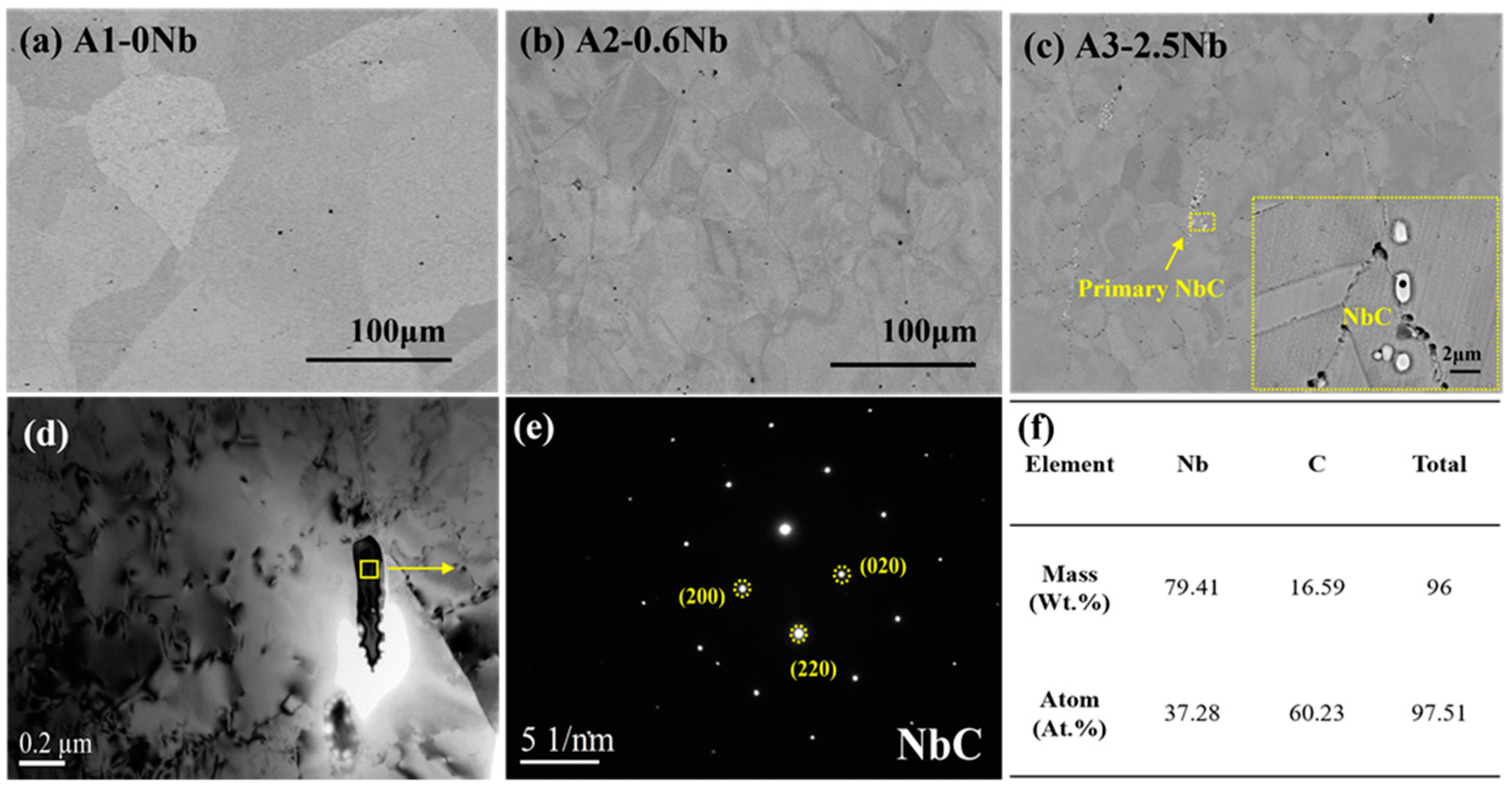


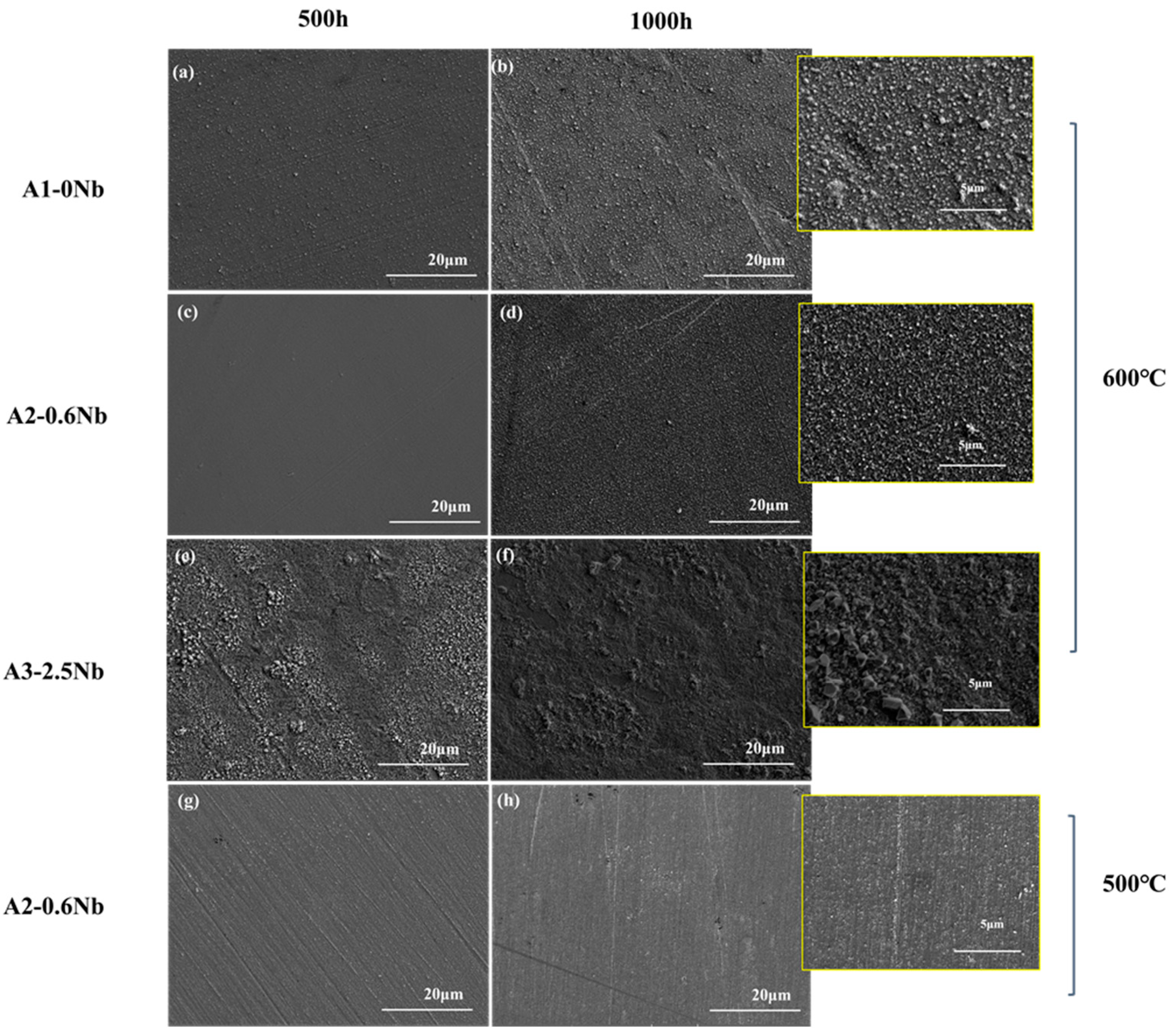


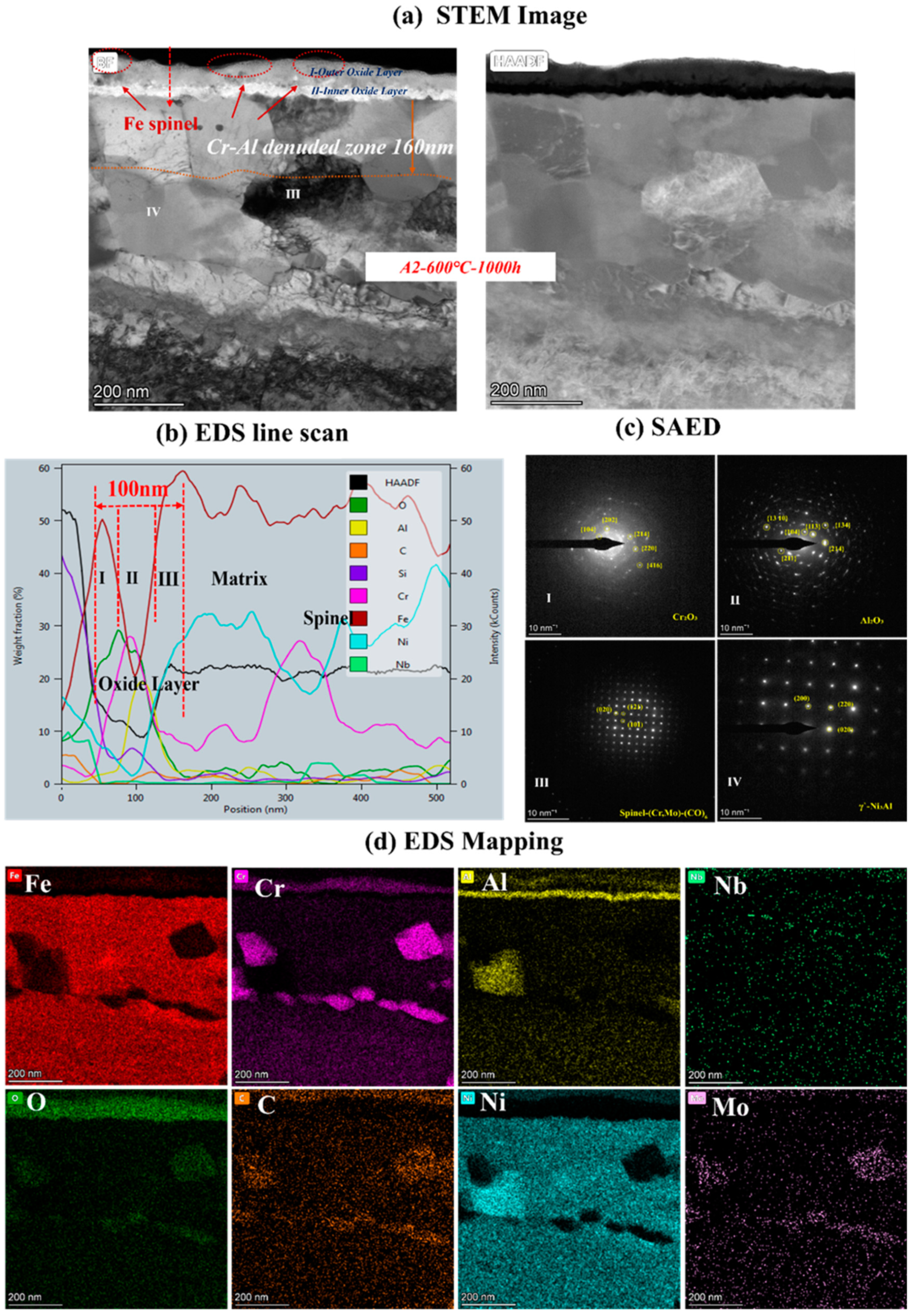
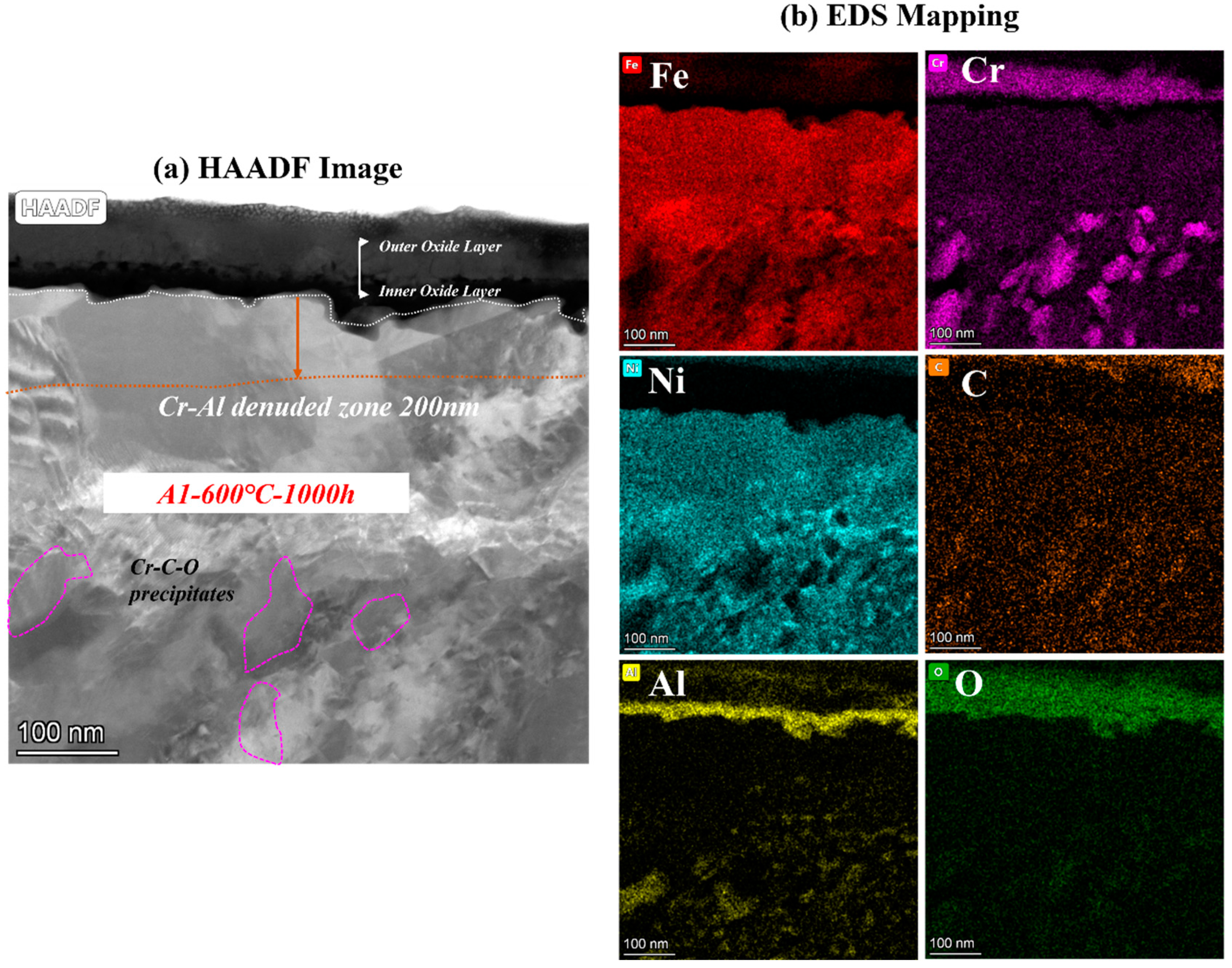


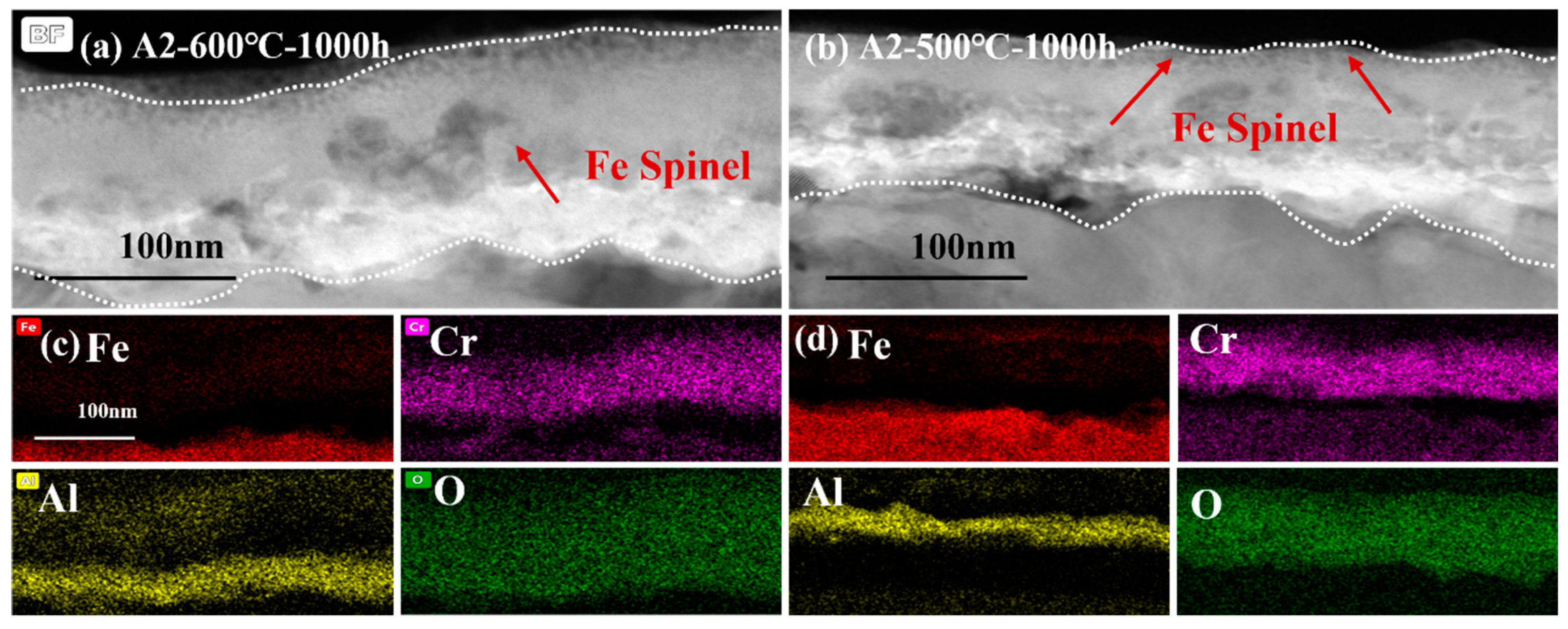
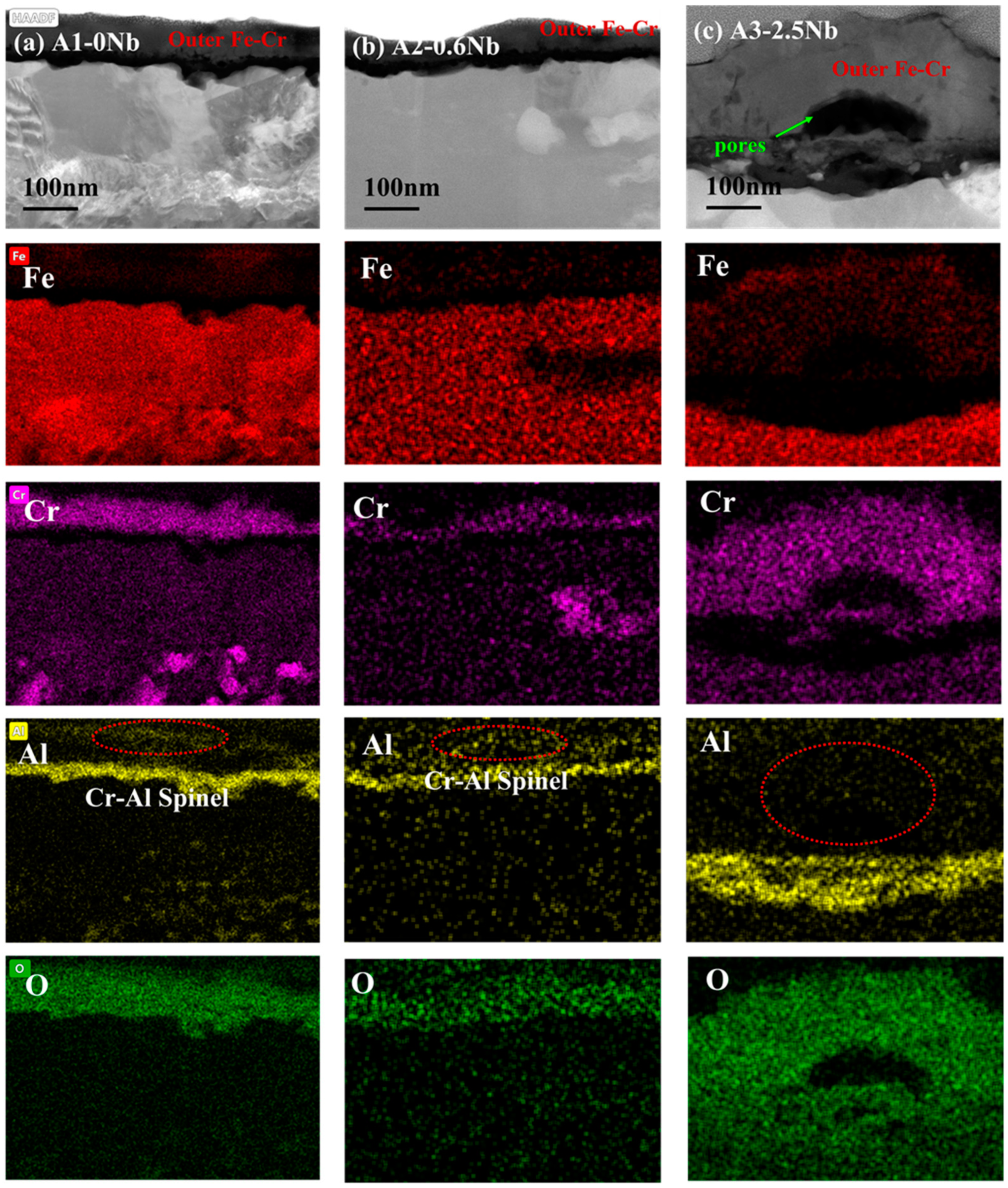

| Materials | Nb | Al | Cr | Ni | Si | Mo | C | Fe | |
|---|---|---|---|---|---|---|---|---|---|
| Normal | A1 | 0 | 3.5 | 18 | 25 | 0.25 | 2 | 0.02 | Bal. |
| A2 | 0.6 | 3.5 | 18 | 25 | 0.25 | 2 | 0.02 | Bal. | |
| A3 | 2.5 | 3.5 | 18 | 25 | 0.25 | 2 | 0.02 | Bal. | |
| Actual | A1 | - | 3.7 | 16.8 | 24.9 | 0.3 | 2.3 | 0.03 | Bal. |
| A2 | 0.61 | 3.6 | 17.1 | 25.29 | 0.3 | 2.2 | 0.04 | Bal. | |
| A3 | 2.89 | 3.7 | 18.1 | 23.5 | 0.3 | 2.1 | 0.03 | Bal. |
Disclaimer/Publisher’s Note: The statements, opinions and data contained in all publications are solely those of the individual author(s) and contributor(s) and not of MDPI and/or the editor(s). MDPI and/or the editor(s) disclaim responsibility for any injury to people or property resulting from any ideas, methods, instructions or products referred to in the content. |
© 2023 by the authors. Licensee MDPI, Basel, Switzerland. This article is an open access article distributed under the terms and conditions of the Creative Commons Attribution (CC BY) license (https://creativecommons.org/licenses/by/4.0/).
Share and Cite
Ma, Z.; Cong, S.; Chen, H.; Liu, Z.; Dong, Y.; Tang, R.; Qiu, T.; Chen, Y.; Guo, X. Corrosion Behavior of Alumina-Forming Austenitic Steel in Supercritical Carbon Dioxide Conditions: Effects of Nb Content and Temperature. Materials 2023, 16, 4081. https://doi.org/10.3390/ma16114081
Ma Z, Cong S, Chen H, Liu Z, Dong Y, Tang R, Qiu T, Chen Y, Guo X. Corrosion Behavior of Alumina-Forming Austenitic Steel in Supercritical Carbon Dioxide Conditions: Effects of Nb Content and Temperature. Materials. 2023; 16(11):4081. https://doi.org/10.3390/ma16114081
Chicago/Turabian StyleMa, Zhaodandan, Shuo Cong, Huan Chen, Zhu Liu, Yuanyuan Dong, Rui Tang, Tian Qiu, Yong Chen, and Xianglong Guo. 2023. "Corrosion Behavior of Alumina-Forming Austenitic Steel in Supercritical Carbon Dioxide Conditions: Effects of Nb Content and Temperature" Materials 16, no. 11: 4081. https://doi.org/10.3390/ma16114081
APA StyleMa, Z., Cong, S., Chen, H., Liu, Z., Dong, Y., Tang, R., Qiu, T., Chen, Y., & Guo, X. (2023). Corrosion Behavior of Alumina-Forming Austenitic Steel in Supercritical Carbon Dioxide Conditions: Effects of Nb Content and Temperature. Materials, 16(11), 4081. https://doi.org/10.3390/ma16114081





